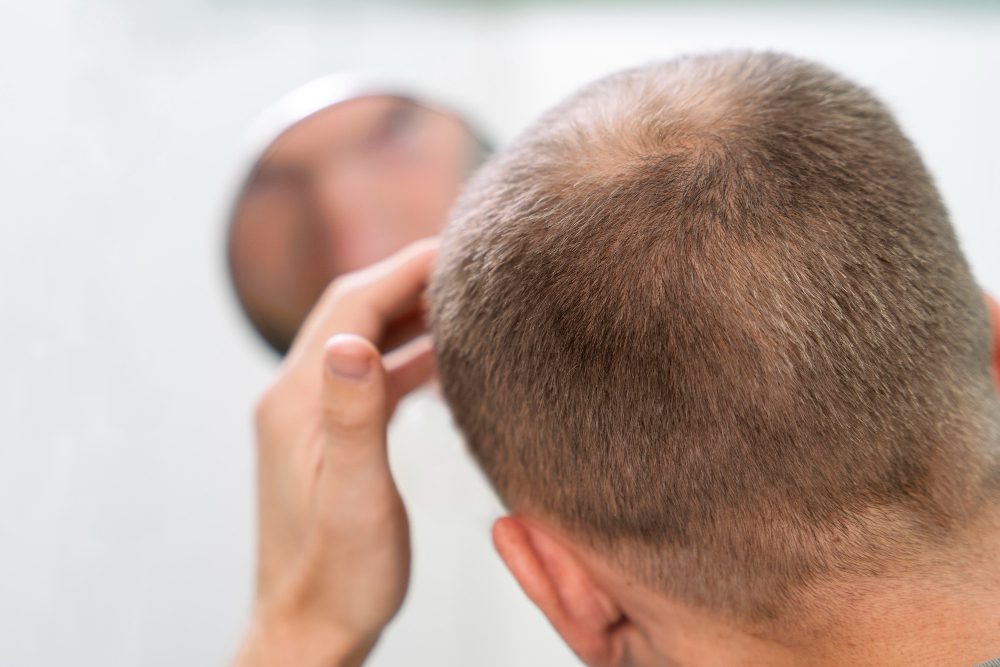Is it normal to still lose hair after 45 days?
This thinning is also called “shock loss” and occurs because the grafting process damages the hair cells. When the transplanted hair follicles enter a dormant phase called the telogen phase, the hairs inside them may fall out. This is a short-term side effect of hair transplant surgery that many people experience.
It is very important that the original hair cells that were transferred are still intact and healthy. After a few months, new hairs will start to grow from the hair shafts. This is the beginning of the anagen phase, also known as the active growth phase. New hair usually starts to grow three to four months after surgery, but it can take 12 to 18 months for the full effects to be seen.
In summary, hair loss is normal and expected 45 days after surgery. If you want to get the best results from your hair transplant, you need to follow your doctor’s instructions after surgery and be patient while you recover. If you have concerns about hair loss or anything else related to your hair transplant recovery, you should talk to your hair restoration specialist.
When does the shedding period usually end?
This process, also known as the “shedding phase” or “shock loss,” usually begins 2 to 6 weeks after a hair transplant. Depending on the individual, this period can last from a few days to a few weeks. By the third month after surgery, most hair loss should have stopped and the grafted hair follicles should have entered the anagen phase, or active growth phase.
Usually, new hair begins to grow three to four months after surgery. However, it is important to remember that the full effects of a hair transplant may not be seen for 12 to 18 months, during which time the transplanted hair will grow and strengthen.
If you want the best results from your hair transplant, you need to follow your surgeon’s post-operative care instructions and be patient during the recovery process. If you have concerns about any part of your hair transplant recovery, especially the shedding phase, you should talk to your hair restoration specialist for help and support.
Can I wash my hair normally 45 days after hair transplantation?
Use a mild shampoo, do not wash your hair too harshly, and keep the water pressure light.
Within 10 to 14 days after surgery, the grafted areas will be more stable on the head and most of the scabs and crusts will fall off. You can now slowly start washing your hair normally. However, depending on your healing process, it is always a good idea to consult with your hair regrowth specialist.
After 45 days of the surgery, you should be past the most important part of the recovery process and washing your hair regularly should not harm the grafts placed. Just remember to follow the instructions or tips given by your hair transplant surgeon.
Is it normal for the donor area to be red, itchy or spotty?
After a transfer, it is normal to experience swelling, pain, or even acne in the area. These are normal side effects that usually go away on their own. However, it is important to monitor these symptoms and see a hair regrowth specialist if they worsen or persist.
Redness: It is normal for the donor area to be slightly red in the days and weeks following surgery. During the healing process, there is more blood flow to the injured area than normal. The redness should gradually subside over a few days to a few weeks.
Itching: Scabs and sores on the scalp can cause itching, another common side effect of the healing process. You should never scratch the area as this can cause the grafts to loosen and spread the infection. If itching becomes unbearable, you should consult your hair transplant surgeon. He or she may recommend a soothing cream or ointment.
Acne: Acne or small pimples in the donor area are common and usually occur in the first few weeks or months of treatment. Most often, this is due to ingrown hairs or new hairs emerging from the skin. Usually, acne will go away on its own. However, if you experience more acne, signs of infection, or excessive itching, you should consult your hair transplant doctor immediately.
Finally, swelling, itching, and acne may occur during the recovery process after a hair transplant. However, keep an eye out for these symptoms and consult your hair transplant surgeon if they persist, worsen, or if there are any concerns. Follow your doctor’s instructions on how to care for yourself after surgery to ensure the best possible recovery and results.
When can I expect new hair growth after hair transplantation?
Most people see new hair growth 3 to 4 months after a hair transplant. It is important to note that this timeline varies from person to person and some people may see new growth sooner or later.
Some hair may fall out during the first few weeks of treatment as the transplanted hair cells enter a dormant phase; this is sometimes referred to as “shock loss.” At this stage of the hair transplant process, the hair cells are generally healthy.
Once the transferred hair cells enter the active anagen phase, new hair will begin to grow. The number of people in the new area will continue to increase over time. In most cases, patients can expect a change in the appearance of their hair 6 to 9 months after surgery.
It is important to remember that you may not see the full benefits of a hair transplant for 12 to 18 months. To get the best results from your hair transplant, you should be patient during the healing process and follow your surgeon’s aftercare instructions carefully. If you have concerns about hair growth or any other issues related to your hair transplant recovery, it is important to consult with your hair restoration specialist.

